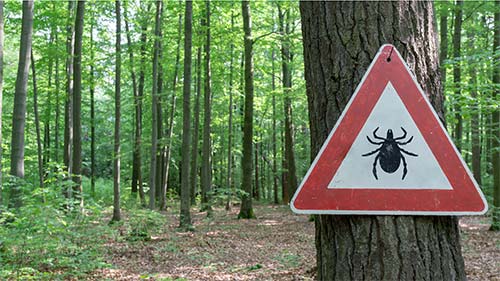Last Updated: June 28, 2022
 Ticks & Lyme Disease
Ticks & Lyme Disease
Lyme disease is the most common disease caused by ticks in Virginia and the United States. For the last 10 years, Virginia has reported over 1,000 cases each year. The CDC estimated that the actual number may be 10 times greater. The number of cases has risen recently, with 2017 being the highest year on record, with 1,652 cases reported.
Lyme disease is usually transmitted by the tiny, black-colored nymph stage Blacklegged Ticks. They measure less than 1/16 of an inch in length. Ticks are mostly found on the ground in wooded areas that have dense leaf litter. Pets may also bring ticks into the home.
Symptoms
Due to this tick’s small size and painless bite, people are often unaware they were bitten unless they see the tick attached to their skin. The first symptom of Lyme disease includes a rash that may appear as a bullseye. Other symptoms include:
- Fever
- Fatigue
- Headache
- Muscle and joint pain
- Swollen lymph nodes
Prevention
To prevent ticks, use Environmental Protection Agency (EPA) registered insect repellents on your shoes, socks, and lower legs containing:
- DEET (20%-50% concentration),
- Picaridin,
- IR3535,
- Oil of Lemon Eucalyptus (OLE),
- Para-menthane-diol (PMD), or
- 2-undecanone
Please follow the label when using any repellent. These repellents are also useful against other ticks and mosquitoes.
Pants, shoes, and socks can also be treated with Permethrin (an insecticide safe for use on clothing worn by people). Carefully follow label instructions on Permethrin when treating clothing. Permethrin should not be directly applied to the skin. Anything treated with it should be completely dry before use. It is advised to tuck your treated pants into your treated socks.
After you return indoors, check your clothing and do a full body check for ticks. Examine gear and pets for ticks and shower within 2 hours of being outdoors. This helps wash off unattached ticks and will help you do a full body check.
